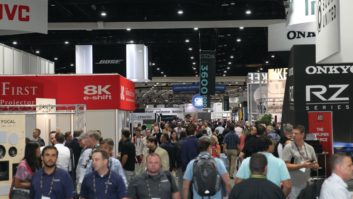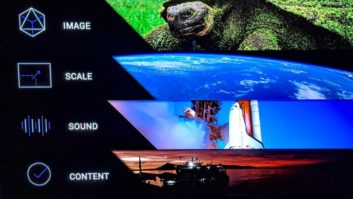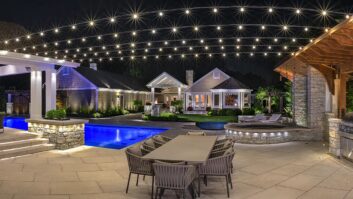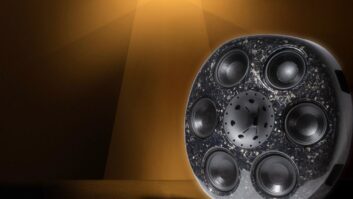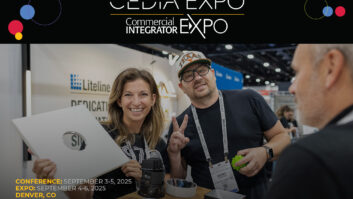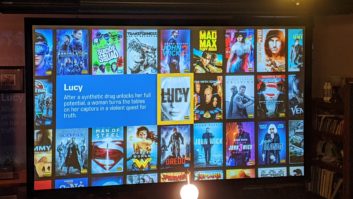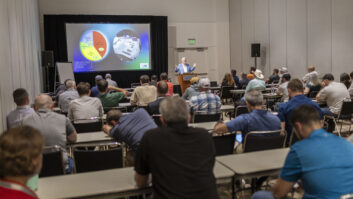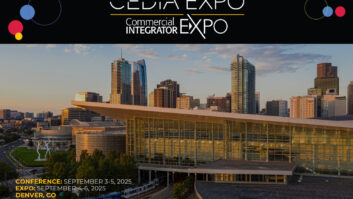DENVER — CEDIA Expo 2014 proved to be a more dynamic show overall than in the recent past, with major companies including Sony and LG using the venue to stake their claims to Ultra HD TV in the custom installation channel.
Their efforts and presence not only attracted media attention, it drew more exhibiters and attendees. Showgoers were treated to several “game-changing” technologies, including the first U.S. viewing of LG’s 4K OLED TVs and giant-screen LED LCD TVs; a diverse range of new Dolby Atoms surround-sound demonstrations; and a bevy of home-integration advancements.
The following are TWICE’s Top 10 Takeaways from this year’s show:
1 Business up double-digits, attendance up single-digits: Expo attendance grew for the second consecutive year, this time by 3 percent to 18,500, and a CEDIA survey found that installers forecast a 20 percent gain in average revenues in 2014 to $1.75 million, up from 2013’s 15 percent gain.
2 4K OLED TVs are finally here: and LG is offering them — 65-inch and 77-inch models — along with new 98- and 105-inch 4K UHD LED LCD TVs through special distribution arrangements with installers, A/V specialists and key regional CE chains.
3 Dolby Atmos, Auro-3D impress: Atmos surround-sound demos hosted by multiple electronics and speaker makers generated excitement, as did the announcement by Paramount Pictures and Warner Bros. that they will release the first movies with Dolby Atmos soundtracks in the fall on Blu-ray disc and through Vudu’s streaming service. Many dealers talked up the show’s most powerful Atmos demo, which used a Trinnov 32-channel Atmos-equipped A/V processor. Data Sat Digital Entertainment’s 20-speaker demonstration of Auro- 3D surround was also powerful.
4 Ultra HD: Most projector manufacturers are still coming to grips with 4K Ultra HD TV. Sony remains the only game in town for true homebased native 4K UHD projectors. DLP, 3LCD and other LCoS-based manufacturers are still awaiting more cost-effective solutions from microdisplay suppliers, and are turning to other solutions.
5 Apps for system setup: Home-automation suppliers turned to apps years ago to let consumers control home systems, and now they’re turning to apps to simplify system set-up for installers.
6 HDMI 2.0 with HDCP 2.2: You won’t be able to passthrough copy-protected UltraHD 4K studio content through an A/V receiver or HDMI matrix switcher that lacks HDCP 2.2 copy protection technology. The first audio products incorporating HDCP 2.2 were displayed by Integra, Onkyo, Krell and Sony, and Leaf Audio showed a matrix A/V switcher.
7 Wireless, wireless, wireless: It’s not new, but using wireless to transmit audio and home-automation control signals around the host continued to gain currency in a market focused more on retrofit installs. The first Z-Wave products from URC and Pro Control were on display, as were URC’s first wireless (ZigBee) light bulbs, a WigWag hub that controls wireless-connected light bulbs, Peerless-AV’s multizone rack-mount wireless-audio system and more.
8 Networked music sources: Networked sources, streaming services and Bluetooth-equipped phones and tablets are the new 100-disc CD changers for multiroom-audio systems. New products turned up from URC, McIntosh, Russoun, and others. Of note: Wired Russound Bluetooth extenders that turn Bluetooth smartphones and tablets in any room into music sources distributed throughout the house.
9 Native UHD Content Options Advance: Netflix is already providing streaming native UHD programming and CEDIA keynoter and Sony president Mike Fasulo revealed that Amazon Prime Instant Video will soon be offering 4K through his sets, and others’ as well. Sony has also made its 4K media player compatible with other brands of 4K UHD sets for 4K movie downloads. In addition, a growing group of native 4K content providers is queing up to feed the expanded field of UHD displays.
10 Surprises: There were a few. One was Deezer’s launch of its 16-bit/44.1kHz FLAC streaming service exclusively through the custom channel. Another was the decision by Apple fanboy Savant to offer an Android app to control its installed home-automation systems.




